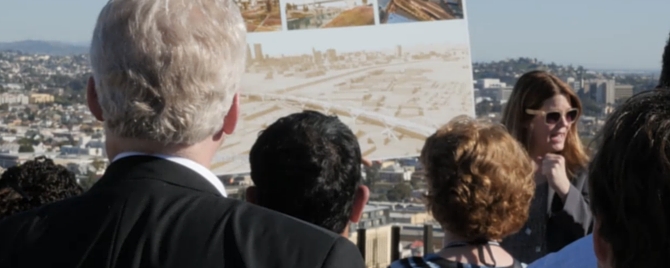Over 1,200 bankers, policymakers, and community development practitioners from around the country recently joined the Federal Reserve Bank of San Francisco’s Community Development team in Los Angeles, CA for the 2016 National Interagency Community Reinvestment Conference (NICRC). Keynotes, breakout sessions, and community tours focused on developing a coordinated approach to improving housing, transportation, education, healthcare, and public safety.
“The economy is not complete unless everyone is healthy, educated, and has an affordable place to call home,” said Scott Turner, SF Fed Community Engagement Vice President, in his opening address. “How do you improve a place and ensure that development does not displace the very people who would and should benefit the most?”
Prosperity is like a Jenga tower: Take one piece out and the whole thing can fall.
John Williams, SF Fed President, stated in his keynote that integrating physical and economic health is key for successful neighborhood revitalization. “Prosperity is like a Jenga tower: Take one piece out and the whole thing can fall. And since well-being is the sum of a host of intertwined factors, finding a path to economic mobility and success means addressing them all.” The definition of health encompasses jobs, education, and safety. “This goes back to the idea that, a tight-knit community is a healthier one, and that every area of community development and revitalization is intertwined.”
Conference attendees only had to look outside to see that a lot has happened in the economy since the last NICRC in 2014. Cranes now dot the skyline outside the JW Marriott conference center, signaling an economic upswing, and yet there is a significant population that has not benefitted from the economic recovery.
A tour of the L.A. River specifically looked at plans to transform parts of Los Angeles from abandoned urban landscape into a community of vibrant neighborhoods, and how redevelopment efforts are expected to impact low-income neighborhoods. The river was redirected through a concrete channel in the 1930s to alleviate flooding, which left most of the surrounding areas as urban blight. A new initiative aims to restore the natural river and revitalize riverside communities through civic and recreational development. To experience a bit of the L.A. river tour for yourself, watch the video below.
Transcript
LAURA CHOI, NARRATOR: A series of devastating floods in 1938 led to the concrete channelization of the L.A. River. Restoring the natural river will transform many parts of the city.
A tour of the L.A. river gave participants the chance to see close-up the challenges and opportunities of this major revitalization effort, which will reconnect neighborhoods, strengthen communities, and restore a relationship to nature. This is part of a national effort to improve urban waterways because of their importance to the health and future of cities everywhere.
This project has the potential to drive significant economic activity and growth. But the tour organizers wanted to show how local policymakers and practitioners are also keeping low-income communities in mind; and working to preserve affordable housing and equitable access to a natural resource that belongs to the entire city.
The 2016 National Interagency Community Reinvestment Conference was sponsored by the Federal Reserve Bank of San Francisco, the Federal Deposit Insurance Corporation, the Office of the Comptroller of the Currency, and the Community Development Financial Institutions Fund (a division of the U.S. Treasury).
The views expressed here do not necessarily reflect the views of the management of the Federal Reserve Bank of San Francisco or of the Board of Governors of the Federal Reserve System.
















